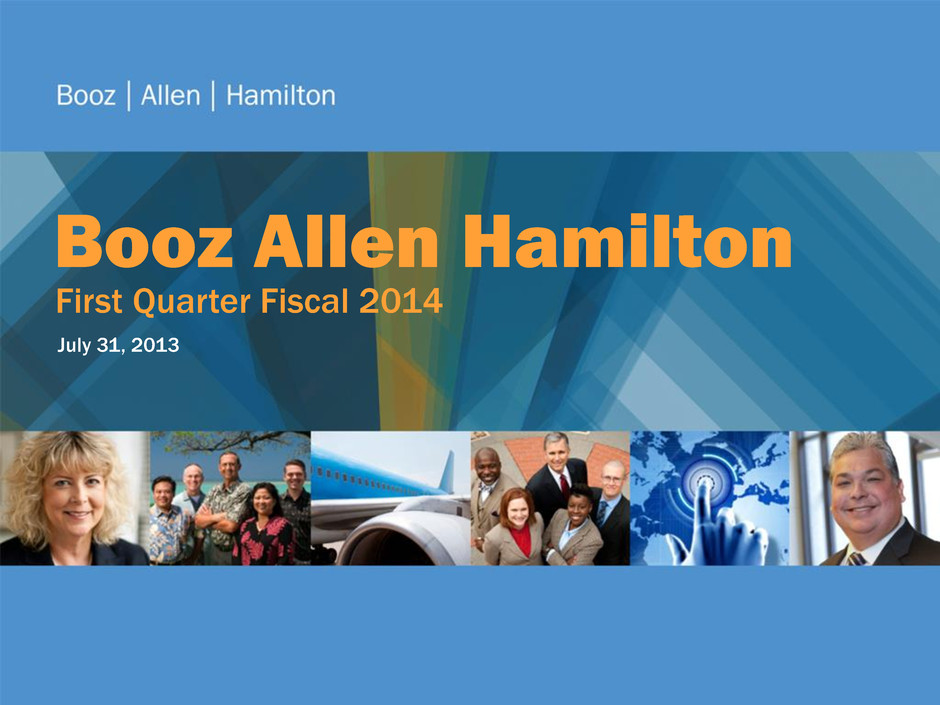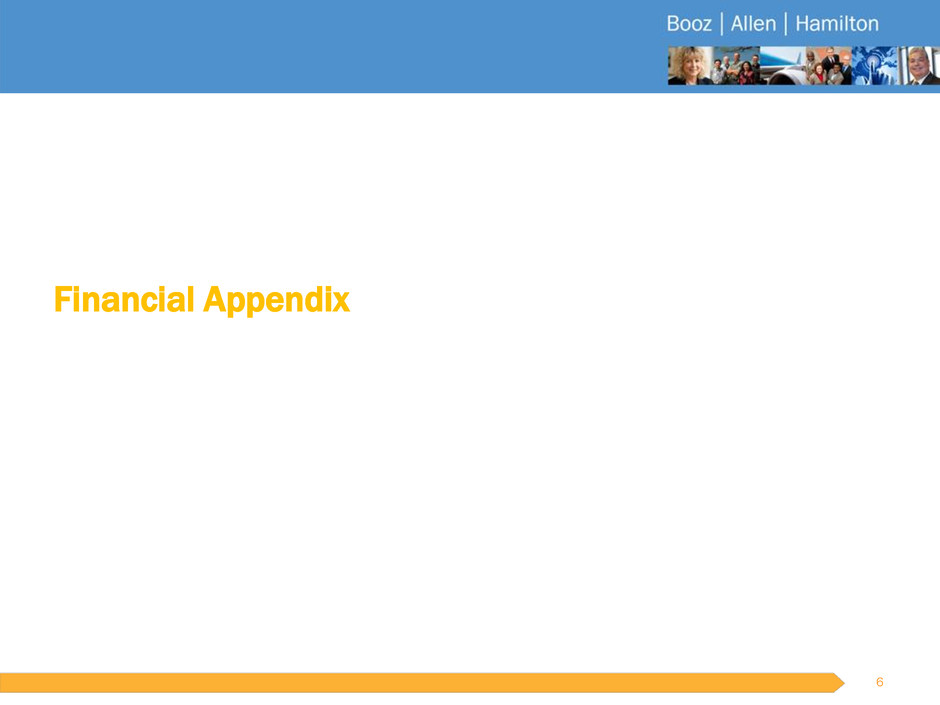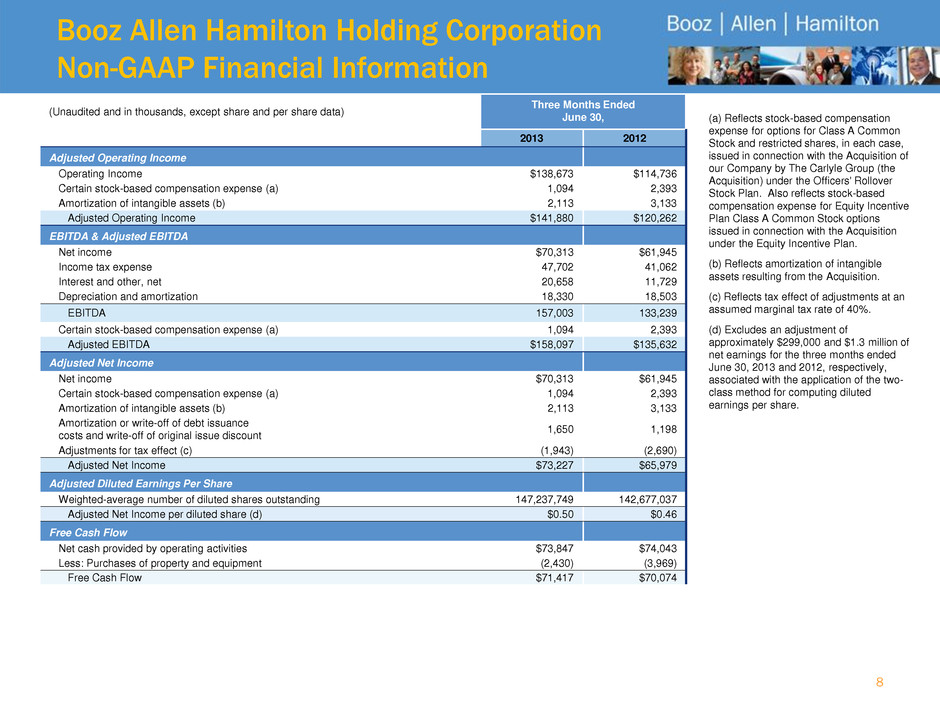Attached files
| file | filename |
|---|---|
| 8-K - 8-K - Booz Allen Hamilton Holding Corp | bah630138k.htm |
| EX-99.1 - EXHIBIT 99.1 - Booz Allen Hamilton Holding Corp | bah63013exhibit991.htm |

July 31, 2013 Booz Allen Hamilton First Quarter Fiscal 2014

Curt Riggle Director, Investor Relations Introduction Today’s Agenda 1 Ralph Shrader Chairman, Chief Executive Officer and President Management Overview Sam Strickland Executive Vice President and Chief Financial Officer Financial Overview Questions and Answers

Disclaimers Forward Looking Safe Harbor Statement The following information includes “forward-looking statements” within the meaning of the Private Securities Litigation Reform Act of 1995. Examples of forward-looking statements include information concerning Booz Allen’s preliminary financial results, financial outlook and guidance, including projected Revenue, Diluted EPS, and Adjusted Diluted EPS, as well as any other statement that does not directly relate to any historical or current fact. In some cases, you can identify forward-looking statements by terminology such as “may,” “will,” “could,” “should,” “forecasts,” “expects,” “intends,” “plans,” “anticipates,” “projects,” “outlook,” “believes,” “estimates,” “predicts,” “potential,” “continue,” “preliminary,” or the negative of these terms or other comparable terminology. Although we believe that the expectations reflected in the forward-looking statements are reasonable, we can give you no assurance these expectations will prove to have been correct. These forward-looking statements relate to future events or our future financial performance and involve known and unknown risks, uncertainties and other factors that may cause our actual results, levels of activity, performance or achievements to differ materially from any future results, levels of activity, performance or achievements expressed or implied by these forward-looking statements. These risks and other factors include: cost cutting and efficiency initiatives, budget reductions, Congressionally mandated automatic spending cuts, and other efforts to reduce U.S. government spending, including automatic sequestration required by the Budget Control Act of 2011 (as amended by the American Taxpayer Relief Act of 2012), which have reduced and delayed and may further reduce or delay contract awards or funding for orders for services especially in the current political environment or otherwise negatively affect our ability to generate revenue under contract awards, including as a result of reduced staffing and hours of operation at U.S. government clients; delayed funding of our contracts due to delays in the completion of the U.S. government's budgeting process and the use of continuing resolutions by the U.S. government to fund its operations or changes in the pattern or timing of government funding and spending (including those resulting from or related to cuts associated with sequestration or other budgetary cuts made in lieu of sequestration); current and continued uncertainty around the timing, extent, and nature of Congressional and other U.S. government action to address budgetary constraints, the U.S. government's ability to incur indebtedness in excess of its current limit and the U.S. deficit; any issue that compromises our relationships with the U.S. government or damages our professional reputation, including negative publicity concerning government contractors in general or us in particular; changes in U.S. government spending, including a continuation of efforts by the U.S. government to decrease spending for management support service contracts, and mission priorities that shift expenditures away from agencies or programs that we support; the size of our addressable markets and the amount of U.S. government spending on private contractors; failure to comply with numerous laws and regulations; our ability to compete effectively in the competitive bidding process and delays or losses of contract awards caused by competitors' protests of major contract awards received by us; the loss of General Services Administration Multiple Award schedule contracts, or GSA schedules, or our position as prime contractor on government-wide acquisition contract vehicles, or GWACs; changes in the mix of our contracts and our ability to accurately estimate or otherwise recover expenses, time, and resources for our contracts; our ability to generate revenue under certain of our contracts; our ability to realize the full value of and replenish our backlog and the timing of our receipt of revenue under contracts included in backlog; changes in estimates used in recognizing revenue; an inability to attract, train, or retain employees with the requisite skills, experience, and security clearances; an inability to hire, assimilate, and deploy enough employees to serve our clients under existing contracts; an inability to timely and effectively utilize our employees; failure by us or our employees to obtain and maintain necessary security clearances; the loss of members of senior management or failure to develop new leaders; misconduct or other improper activities from our employees or subcontractors, including the improper use or release of our clients' sensitive or classified information; increased insourcing by various U.S. government agencies due to changes in the definition of “inherently governmental” work, including proposals to limit contractor access to sensitive or classified information and work assignments; increased competition from other companies in our industry; failure to maintain strong relationships with other contractors; inherent uncertainties and potential adverse developments in legal or regulatory proceedings, including litigation, audits, reviews, and investigations, which may result in materially adverse judgments, settlements, withheld payments, penalties, or other unfavorable outcomes including debarment, as well as disputes over the availability of insurance or indemnification; continued efforts to change how the U.S. government reimburses compensation related and other expenses or otherwise limit such reimbursements, including recent rules that expand the scope of existing reimbursement limitations and an increased risk of compensation being deemed unallowable or payments being withheld as a result of U.S. government audit, review or investigation; internal system or service failures and security breaches, including, but not limited to, those resulting from external cyber attacks on our network and internal systems; risks related to changes to our operating structure, capabilities, or strategy intended to address client needs, grow our business or respond to market developments; risks associated with new relationships, clients, capabilities, and service offerings in our U.S. and international businesses; failure to comply with special U.S. government laws and regulations relating to our international operations; risks related to our indebtedness and credit facilities which contain financial and operating covenants; the adoption by the U.S. government of new laws, rules, and regulations, such as those relating to organizational conflicts of interest issues or limits; risks related to completed and future acquisitions, including our ability to realize the expected benefits from such acquisitions; an inability to utilize existing or future tax benefits, including those related to our stock-based compensation expense, for any reason, including a change in law; variable purchasing patterns under U.S. government GSA schedules, blanket purchase agreements and indefinite delivery, indefinite quantity, or ID/IQ, contracts. Additional information concerning these and other factors can be found in our filings with the Securities and Exchange Commission (SEC), including our Annual Report on Form 10-K, filed with the SEC on May 23, 2013. All forward-looking statements attributable to Booz Allen or persons acting on Booz Allen’s behalf are expressly qualified in their entirety by the foregoing cautionary statements. All such statements speak only as of the date made and, except as required by law, Booz Allen undertakes no obligation to update or revise publicly any forward-looking statements, whether as a result of new information, future events or otherwise. Note Regarding Non-GAAP Financial Data Information Booz Allen discloses in the following information Adjusted Operating Income, Adjusted EBITDA, Adjusted Net Income, Adjusted Diluted EPS, and Free Cash Flow which are not recognized measurements under GAAP, and when analyzing Booz Allen’s performance or liquidity as applicable, investors should (i) evaluate each adjustment in our reconciliation of Operating and Net Income to Adjusted Operating Income, Adjusted EBITDA and Adjusted Net Income, and cash flow to free cash flow, and the explanatory footnotes regarding those adjustments, and (ii) use Adjusted EBITDA, Adjusted Net Income, Adjusted Operating Income, and Adjusted Diluted EPS in addition to, and not as an alternative to operating income, net income or Diluted EPS as a measure of operating results with cash flow in addition to and not as an alternative to net cash generated from operating activities as a measure of liquidity, each as defined under GAAP. The Financial Appendix includes a reconciliation of Adjusted Operating Income, Adjusted EBITDA, Adjusted Net Income, Adjusted Diluted EPS, and Free Cash Flow to the most directly comparable financial measure calculated and presented in accordance with GAAP. Booz Allen presents these supplemental performance measures because it believes that these measures provide investors and securities analysts with important supplemental information with which to evaluate Booz Allen’s performance, long term earnings potential, or liquidity, as applicable and to enable them to assess Booz Allen’s performance on the same basis as management. These supplemental performance and liquidity measurements may vary from and may not be comparable to similarly titled measures by other companies in Booz Allen’s industry. 2

Fiscal 2014 Business Highlights ► First Quarter Fiscal Year 2014 Revenue down slightly (0.3%) ► Continued growth in margins, operating income, and adjusted earnings ► $0.10 recurring quarterly dividend ► Serving clients with the highest quality work and commitment to their mission ► Investing in capabilities for clients today and for growth in the future ► Ongoing commitment to people development and community service ► Effective cost management in Q1 provides flexibility for remainder of year ► Booz Allen Engineering Services (BES) performance provides encouraging support for Engineering strategy 3

Key Financial Highlights Preliminary First Quarter Fiscal 2014 Results Comparisons are to prior fiscal year period 4 Revenue $1.43 billion 0.3% Decline Adjusted Net Income $73.2 million 11.0% Increase Net Income $70.3 million 13.5% Increase Adjusted EBITDA $158.1 million 16.6% Increase Adjusted Diluted EPS $0.50/share Up from $0.46/share Diluted EPS $0.48/share Up from $0.43/share Total Backlog $11.27 billion 10.1% Increase

Outlook Revenue growth forecast: Low Single Digit Decline for the Full Fiscal 2014 Diluted EPS forecast (1): $1.47 - $1.57 Adjusted Diluted EPS forecast (1): $1.55 - $1.65 5 (1) Full Fiscal Year 2014 Estimated Weighted Average Diluted Share Count: 149.0 million Fiscal 2014 Full Year Outlook

Financial Appendix 6

Booz Allen Hamilton Holding Corporation Non-GAAP Financial Information ► “Adjusted Operating Income” represents Operating Income before (i) certain stock option-based and other equity-based compensation expenses, (ii) adjustments related to the amortization of intangible assets, and (iii) any extraordinary, unusual, or non-recurring items. Booz Allen prepares Adjusted Operating Income to eliminate the impact of items it does not consider indicative of ongoing operating performance due to their inherent unusual, extraordinary or non- recurring nature or because they result from an event of a similar nature. ► “Adjusted EBITDA” represents net income before income taxes, net interest and other expense and depreciation and amortization and before certain other items, including: (i) certain stock option-based and other equity-based compensation expenses, (ii) transaction costs, fees, losses, and expenses, including fees associated with debt prepayments, and (iii) any extraordinary, unusual or non-recurring items. Booz Allen prepares Adjusted EBITDA to eliminate the impact of items it does not consider indicative of ongoing operating performance due to their inherent unusual, extraordinary or non-recurring nature or because they result from an event of a similar nature. ► “Adjusted Net Income” represents net income before: (i) certain stock option-based and other equity-based compensation expenses, (ii) transaction costs, fees, losses, and expenses, including fees associated with debt prepayments, (iii) adjustments related to the amortization of intangible assets, (iv) amortization or write-off of debt issuance costs and write-off of original issue discount and (v) any extraordinary, unusual or non-recurring items, in each case net of the tax effect calculated using an assumed effective tax rate. Booz Allen prepares Adjusted Net Income to eliminate the impact of items, net of taxes, it does not consider indicative of ongoing operating performance due to their inherent unusual, extraordinary or non-recurring nature or because they result from an event of a similar nature. ► “Adjusted Diluted EPS” represents Diluted EPS calculated using Adjusted Net Income as opposed to Net Income. Additionally, Adjusted Diluted EPS does not contemplate any adjustments to Net Income as required under the two- class method of calculating EPS as required in accordance with GAAP. ► “Free Cash Flow” represents the net cash generated from operating activities less the impact of purchases of property and equipment. 7

Booz Allen Hamilton Holding Corporation Non-GAAP Financial Information 8 (Unaudited and in thousands, except share and per share data) Three Months Ended June 30, 2013 2012 Adjusted Operating Income Operating Income $138,673 $114,736 Certain stock-based compensation expense (a) 1,094 2,393 Amortization of intangible assets (b) 2,113 3,133 Adjusted Operating Income $141,880 $120,262 EBITDA & Adjusted EBITDA Net income $70,313 $61,945 Income tax expense 47,702 41,062 Interest and other, net 20,658 11,729 Depreciation and amortization 18,330 18,503 EBITDA 157,003 133,239 Certain stock-based compensation expense (a) 1,094 2,393 Adjusted EBITDA $158,097 $135,632 Adjusted Net Income Net income $70,313 $61,945 Certain stock-based compensation expense (a) 1,094 2,393 Amortization of intangible assets (b) 2,113 3,133 Amortization or write-off of debt issuance costs and write-off of original issue discount 1,650 1,198 Adjustments for tax effect (c) (1,943) (2,690) Adjusted Net Income $73,227 $65,979 Adjusted Diluted Earnings Per Share Weighted-average number of diluted shares outstanding 147,237,749 142,677,037 Adjusted Net Income per diluted share (d) $0.50 $0.46 Free Cash Flow Net cash provided by operating activities $73,847 $74,043 Less: Purchases of property and equipment (2,430) (3,969) Free Cash Flow $71,417 $70,074 (a) Reflects stock-based compensation expense for options for Class A Common Stock and restricted shares, in each case, issued in connection with the Acquisition of our Company by The Carlyle Group (the Acquisition) under the Officers' Rollover Stock Plan. Also reflects stock-based compensation expense for Equity Incentive Plan Class A Common Stock options issued in connection with the Acquisition under the Equity Incentive Plan. (b) Reflects amortization of intangible assets resulting from the Acquisition. (c) Reflects tax effect of adjustments at an assumed marginal tax rate of 40%. (d) Excludes an adjustment of approximately $299,000 and $1.3 million of net earnings for the three months ended June 30, 2013 and 2012, respectively, associated with the application of the two- class method for computing diluted earnings per share.
